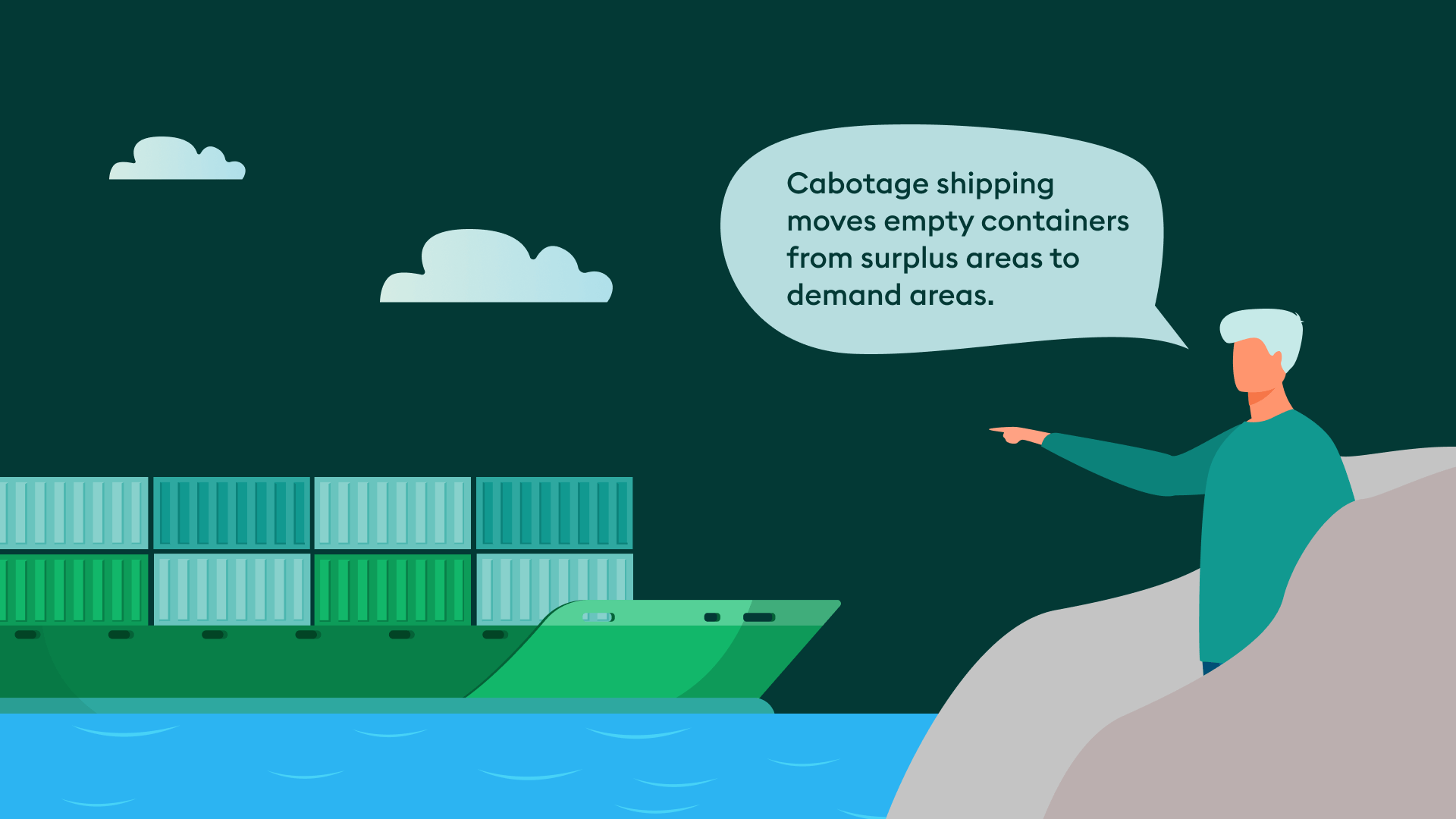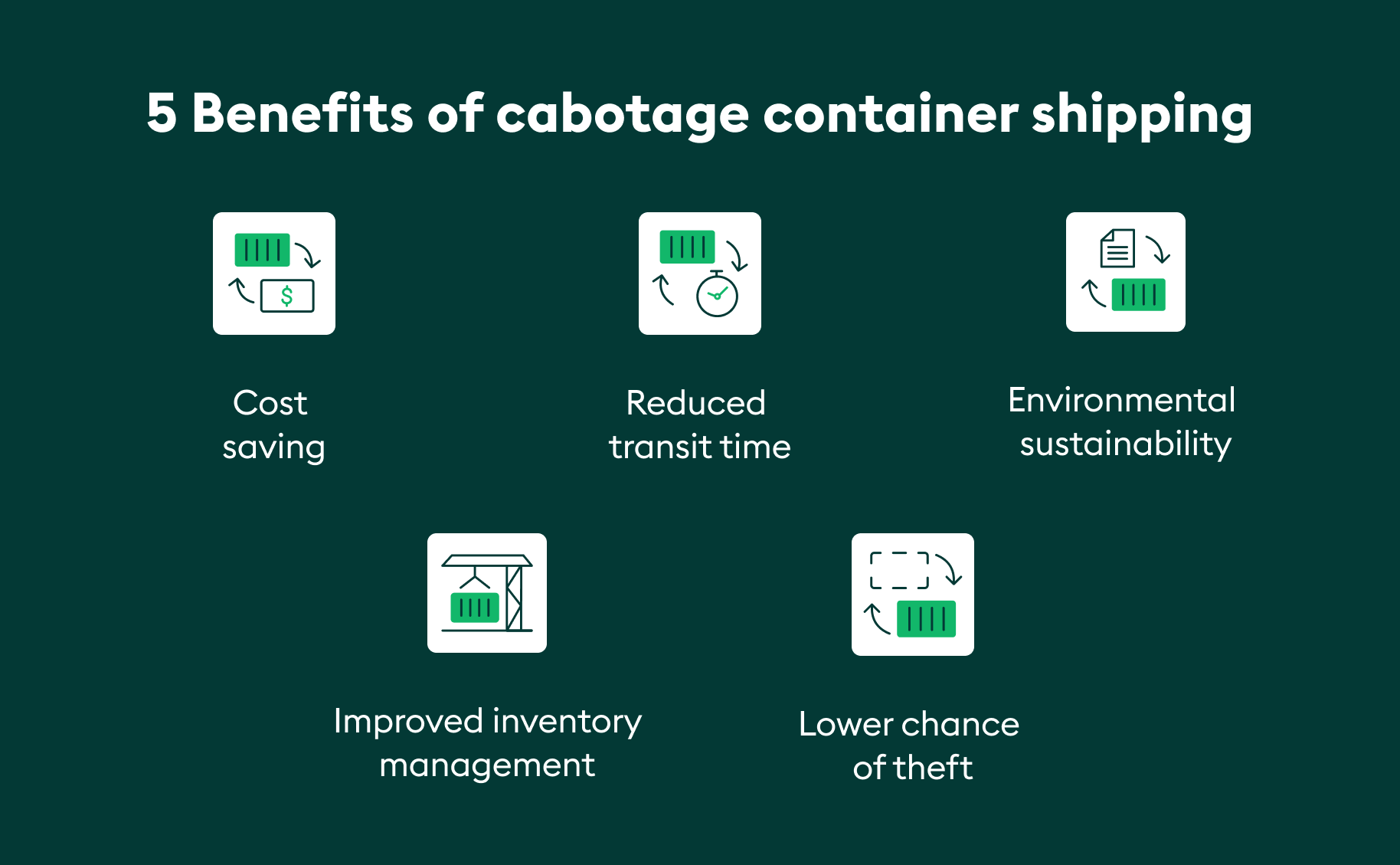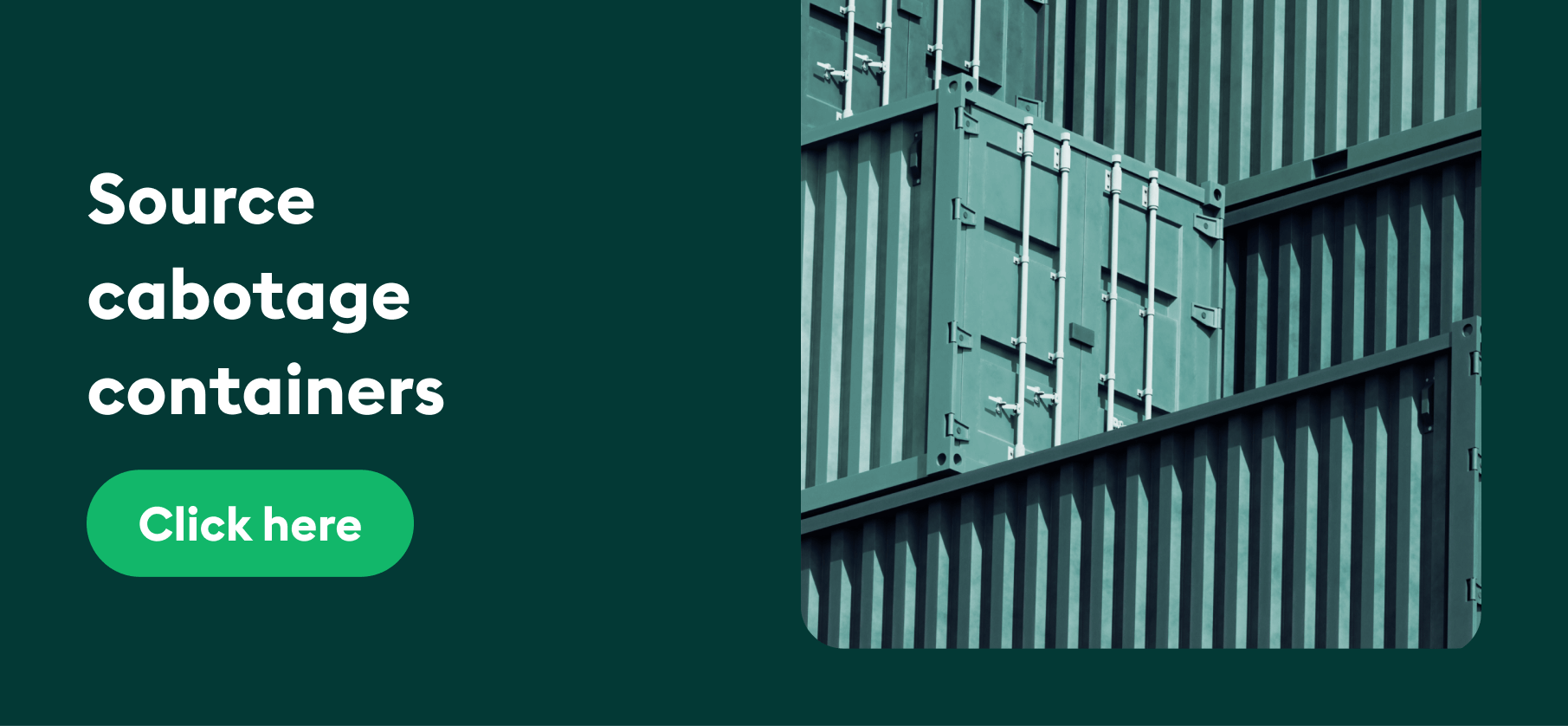The cabotage container can be beneficial to you and your business in many ways. And if you’re curious to know how, then read this blog to get a comprehensive overview of how “cabotaging” your containers protects you from extra expenditures during shipping.
In order to understand cabotage containers, you need to explore the issue of empty container repositioning. This is a common occurrence in container logistics. This movement of empty containers represents wasted capacity, especially on routes where substantial domestic traffic is available for parallel movement by road or rail. It’s also an extremely costly affair.
There have been many techniques used to combat empty container repositioning. The most effective has proven to be one-way container movement, or “cabotaging”. This is where you find a container user to fill your empty container with their cargo and move it one way, across the stretch that you require. So, if you have some empty containers to move, then Container xChange can help you reposition them.
With Container xChange, you can immediately update your one-way offers and interact with trusted partners online. There’s also a safe and easy-to-use payment function that provides you with one consolidated bill and manages all of your transactions on one simple platform. Not to mention insurance options, real-time tracking and more benefits.
Our public search feature allows you to find deals for one way moves in no time. You just need to choose ‘I want to supply containers’, type in your preferred pickup and drop off locations and hit search. You’ll then see a list of vetted users who are ready to use your empty boxes – it’s as simple as that! Check it out below!
What is a cabotage container and why is it important?

The term “cabotage container shipping” refers to the repositioning of empty containers from an area where there’s an excessive number of boxes (surplus), to one where there’s a shortage of them (deficit). A one-way container is also known as a cabotage container. Organizations like CONCOR (Container Corporation of India) offer the facility of “cabotage” to shipping lines that wish to move empty containers to correct any container imbalances.
A “cabotaged” container is effectively loaned by the shipping company to the carrier (CONCOR) for a very short period (one-way trip). During this trip, the carrier is permitted to use the container for the movement of domestic cargo.
By “cabotaging” these containers, CONCOR can therefore offer a substantial discount to both shipping lines and the potential domestic client. This is an area of focus and strategy to boost volumes and profitability. This is done by providing the assets temporarily to a different company. The firm then uses the boxes for its own freight, and they’re returned to a location where the container owner needs them again.
So, as a container user, you get your cargo moved to its desired location by paying the usual freight charges. And as a supplier you lease your box for one journey, without incurring the costs of empty container repositioning and other port surcharges. It’s ideally a win-win situation and benefits both parties involved. And what makes this entire process even better is if you have access to SOC containers.
Shipper-owned containers offer several benefits, including cost savings over time through reduced leasing fees, increased control over container availability and quality, and improved supply chain flexibility. However, finding reliable suppliers for these boxes might not be easy, that’s where Container xChange can help.
Our platform gives you access to a dynamic network of SOC containers, sparing you the headache of repositioning costs. You can browse through company profiles, reviews, and ratings to connect with SOC providers that match your leasing needs for one way moves. Reach out to one of our experts today and see how we make one way moves a whole lot smoother!
What are cabotage shipping laws?
Cabotage laws regulate domestic maritime transport, limiting foreign-owned vessels to enter a country’s coastal waters. These laws protect a nation’s shipping industry and encourage local growth.
Let’s understand this better with an example:
The Ministry of Shipping established a cabotage law to protect India’s local shipping industry along its coasts. This law is part of the Merchant Shipping Act, 1958 and here’s what it states:
- Only ships registered in India can travel on routes along India’s coasts to transport goods.
- Foreign ships can operate along the coast if there are no Indian ships available. But they need a license from the Directorate General of Shipping.
- In 2018, the Shipping Ministry made changes to the cabotage rules. Foreign ships were allowed to carry loaded containers meant for transfer on domestic routes without a DG Shipping license.
These laws aimed to protect Indian shipping, didn’t work out well. And as India tightened their laws, other countries eased their cabotage regulations to boost trade, and their ports became major transshipment hubs. This put India at a disadvantage. For example, Colombo port in Sri Lanka and Singapore port became tough competitors for India.
Due to this growing competition, Indian authorities loosened the reigns a bit and made changes that were more lenient. These changes were as follows:
- Stop more and more Indian cargo from being handled in foreign ports.
- Help farmers sell their products in bigger markets and make more profit.
- Improve trade and make doing business in India easier.
- Connect India better through the Sagar Mala project, which focuses on maritime development.
Now that you’re aware of the impact that these laws have, let’s look at how cabotage containers can benefit you:
5 benefits of cabotage containers
As previously mentioned, cabotage container shipping can be beneficial for both user and supplier. This is done by offering a simple solution to a problem that both parties may face. To breakdown these advantages even further, take a look at the 5 benefits of cabotage containers:
Cost saving
Cabotage container shipping can provide cost-effective transportation solutions for shipping container businesses by utilizing domestic vessels and crew. It may result in lower transportation costs compared to international shipping. It can also help minimize customs duties, taxes, and other fees associated with cross-border shipments.
Reduced transit time
Cabotage container shipping optimizes supply chain visibility and logistics by shipping through direct routes between domestic ports, reducing transit times, and eliminating the need for intermediate transshipment points. This results in streamlined operations, improved inventory management, and faster delivery times.
Environmental sustainability
Cabotage container shipping contributes to sustainable logistics efforts as it often involves shorter distances and domestic vessels. This leads to reduced greenhouse gas emissions compared to long-haul international shipping. So, it aligns with the environmental and sustainability goals of many businesses and can enhance their corporate social responsibility (CSR) initiatives.
Improved inventory management
With shorter distances, direct routes, and domestic transportation, cabotage container shipping enables your business to better plan inventory levels. By doing so, you can reduce stockouts and replenishment delays. This aligns inventory with production schedules and demand fluctuations and enables proactive inventory management.
Lower chance of theft
Cabotage container shipping can lower theft risks through reduced transshipment points, enhanced security measures, familiarity with local shipping regulations, as well as container tracking and monitoring capabilities. It’s important for you to be able to work closely with reputable shipping providers and implement appropriate security measures to further mitigate theft risks in your cabotage container shipping operations.
Source a cabotage container on Container xChange to avoid repositioning costs
With benefits galore, it’d be a good idea for your business to invest in cabotaging your containers as container repositioning can be a costly affair for container owners such as yourself. Just, picture the benefits of being able to cut down on expenses while still getting your containers to where they’re needed. That’s where ‘cabotaging’ comes in.
Now, if you’re looking to move your empty container from, say Hamburg, Germany to Los Angeles, USA it’s not easy to find a reliable and trustworthy user to move your box for you, is it?
Well, Container xChange is here to help with that. Our platform operates like a matchmaking provider for container suppliers and users. xChange instantly connects you with the perfect fit for your one-way move, sparing you the hassle of searching endlessly for certified users. Our network of over 1500 members across 2500+ locations ensure you can find the right container user to take your box to where you need it.
You can also review company profiles on our platform. So, you can make more informed decisions as to who you’re working with. All our members go through an extensive vetting process. This ensures safety and establishes a more trustworthy relationship between user and supplier – 100% transparency!
We’re here to make your negotiations smoother, your work faster, and your one-way move hassle-free. Click on the banner below and join us on Container xChange. Unlock a new era of efficient, cost-effective, and streamlined container operations.
Find top routes and prices for repositioning empty units with xChange’s market report
With your box ready for a one way move, you mustn’t overlook a few more important factors such as the latest market trends, and top routes and prices to reposition your empties. This can help you snag the best deals, avoid unnecessary container charges and make better decisions for your business.
By leveraging Container xChange’s market logistics report, you’re able to do just that. Our report, ‘Where Are All The Containers?’ provides you with the most up-to-date information on the current market, as well as the best time, prices, and routes to reposition empty containers.
Have a look at the latest stats we covered in our August Edition:
- Exports in Asia have slumped for the eleventh consecutive month. This means that there’s less demand for containers leaving Asian ports. This causes a negative impact on the country’s GDP growth.
- The Middle East has seen a major drop in prices despite their ports’ high performance. The average container prices in the Middle East were at the lowest in July since 2021. While the price for a 40ft cargo-worthy container in Jebel Ali was $3,183 in July 2022, it was $918 a year later, almost a 75% decrease.
- Key ports in Europe continue to see a steady decline in containers, as well as their prices. The port of Antwerp reported an average drop of 5.5% in the first half of 2023 compared to 2022. Port of Antwerp also recently reported a container decline of 5.9% year-on-year.
- US imports are down, facing a 21.5% drop from April 2022. Hopes of a peak season doesn’t seem promising
As you can see, our dedicated research team is constantly studying the market to identify the most liquid locations to reposition your empties as well as get you the latest news on labor strikes, port congestion and more! So, if you want more in-depth insights into the current market situation, download our latest WAATC report here!
Cabotage container shipping vs. international container shipping
Now that you’ve been familiarized with cabotage containers, you’re probably wondering how they differ from standard international shipping. The table below explains their differences:
| Cabotage container shipping | International container shipping |
| Cabotage container shipping refers to the transportation of goods by sea or land within the domestic jurisdiction of a single country, typically limited to coastal or domestic routes. | International container shipping involves the transportation of goods across national borders, often involving multiple countries and crossing international waters. |
| This form of shipping is subject to the regulations and laws of the country where it operates, including customs regulations, trade policies, and transportation rules specific to that country. | It involves compliance with the regulations and laws of multiple countries, including customs clearance procedures, trade agreements, and transportation regulations of each country along the shipping route. |
| It is also typically limited to domestic market access within a single country. | Provides access to global markets and international trade opportunities, involving cross-border trade with multiple countries. |
How Container xChange can help you source cabotage containers to curb empty container repositioning
As you observed above, the market is not always transparent when it comes to cabotage container shipping. Finding partners, negotiating and administering contracts, billing and invoicing are still some challenges that you might face. This can also be a time-consuming process. However, at Container xChange, we aim to make this market more accessible, transparent, and resourceful for you.
Cabotage container shipping requires flexibility and efficiency, and Container xChange’s one-way leasing option is the perfect solution for your cabotage container needs. You’ll be able to easily lease containers and negotiate deals for one-way moves on our platform.
As a container user, you have a certain free period (typically 90 days) to use the container. Thus, you can keep the costs for the move at a minimum or optimal level or even eliminate them completely.
As an owner, you find and work with only certified users to move your boxes one way. You can also automatically update your one-way offers and connect with a vast network of vetted suppliers. So, it’s easy to find available containers for your cabotage routes. This allows you to save on the cost of repositioning and improves your company’s carbon footprint.
Every member on our platform fills out the industry standard contract – the BIMCO agreement. With BIMCO, you can have the bill of lading and other standard agreements available to you in an electronic format with BIMCO’s online pay-as-you-go charter party editing system. This helps in facilitating smoother negotiations and accelerating the work process.
You’ll also be able to browse 50,000+ containers available in 2500+ locations. Compare various prices upfront and negotiate deals that best suit your budget, thanks to our complete market price transparency – It’s time to find boxes at competitive prices with zero hidden fees.
So, click the banner below to join the Container xChange family and streamline your cabotage container logistics like never before!
Cabotage Container: Common FAQS
What is a cabotage container?
A cabotaged container is effectively loaned by the shipping company to the carrier for a very short period, usually a single one way trip.
Why is it called cabotage?
The term originates from the shipping industry and is referred to coastal shipping, the journey from cape to cape along the coast. Cabotage is based on the French “caboter” for “going from port to port”.
What are the advantages of a cabotage container?
The advantages can be perceived in the form of lower insurance costs, lower risk of accidents, and lower chances of cargo being robbed or stolen. Therefore, the merchandise has a greater guarantee.
What is the Jones Act law?
The Jones Act, also known as the Merchant Marine Act of 1920, is a federal statute establishing support for the development and maintenance of a merchant marine in order to support commercial activity and serve as a naval auxiliary in times of war or national emergency.





